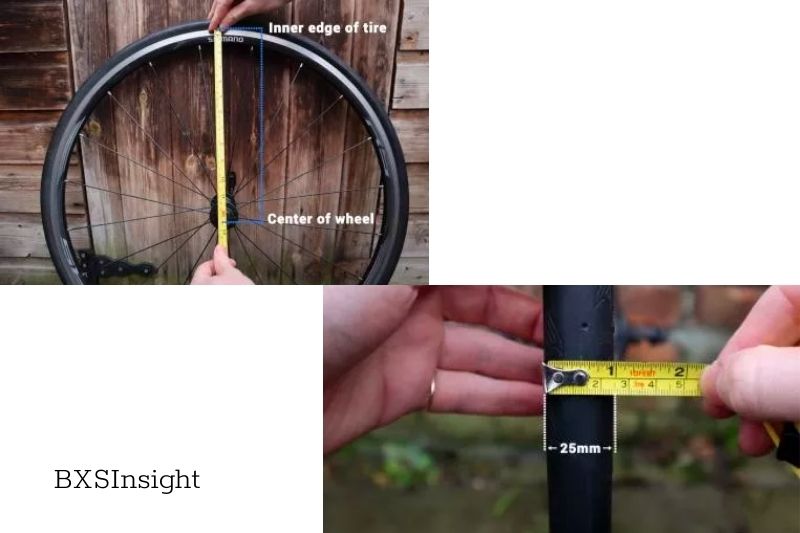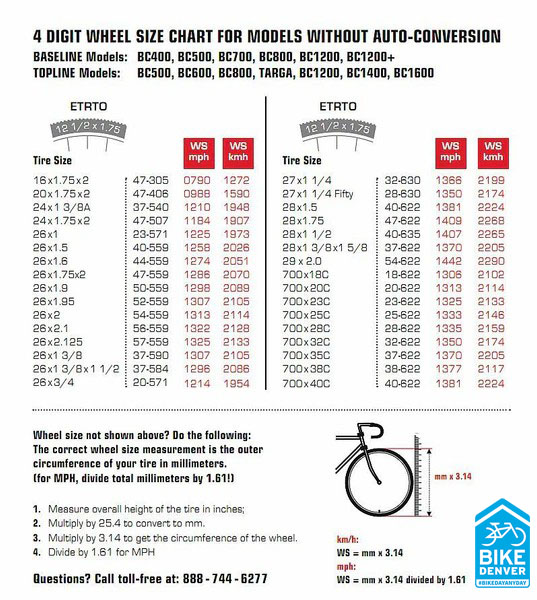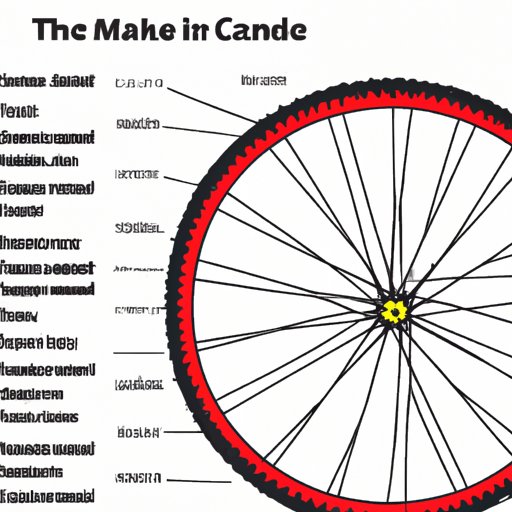Understanding the Importance of Wheel Size
Wheel size plays a crucial role in determining a bike’s performance, comfort, and safety. The right wheel size can significantly impact the overall riding experience, affecting factors such as speed, stability, and maneuverability. A bicycle wheel size guide can help riders choose the perfect wheels for their bike and riding style.
Wheel size affects the bike’s geometry, influencing the position of the rider and the bike’s handling. Larger wheels, such as 29″ wheels, provide a smoother ride and better stability at high speeds, making them ideal for road biking and cross-country mountain biking. On the other hand, smaller wheels, such as 26″ wheels, offer better maneuverability and are often preferred for downhill mountain biking and technical trails.
The wheel size also impacts the bike’s comfort level. A wheel size that is too small can result in a harsh ride, while a wheel size that is too large can make the bike feel sluggish. Additionally, the wrong wheel size can affect the bike’s safety, as it can alter the bike’s handling and stability.
Furthermore, wheel size can influence the bike’s efficiency. Larger wheels tend to be more efficient, as they cover more ground with each rotation, resulting in faster speeds. However, smaller wheels can be more efficient in certain situations, such as when navigating tight corners or technical trails.
In conclusion, wheel size is a critical factor in determining a bike’s performance, comfort, and safety. By understanding the importance of wheel size and choosing the right size for their bike and riding style, riders can optimize their riding experience and get the most out of their bike. A comprehensive bicycle wheel size guide can provide valuable insights and help riders make informed decisions when selecting the perfect wheels for their bike.
How to Measure Your Bike for the Perfect Wheel Fit
To determine the ideal wheel size for your bike, you’ll need to take a few measurements. This step-by-step guide will walk you through the process, ensuring you get the perfect wheel fit for your ride.
**Step 1: Measure the Frame Size**
Start by measuring the length of your bike’s frame, from the center of the bottom bracket to the top of the seat tube. This will give you an idea of the overall size of your bike. Use a tape measure or a ruler to take the measurement in inches or centimeters.
**Step 2: Measure the Tire Width**
Next, measure the width of your tires. This is important, as it will affect the overall diameter of your wheel. Use a caliper or a ruler to measure the width of your tire in inches or millimeters.
**Step 3: Consider Your Riding Style**
Think about your riding style and the type of terrain you’ll be riding on. If you’re a road biker, you’ll want a wheel size that provides speed and efficiency. If you’re a mountain biker, you’ll want a wheel size that offers stability and control.
**Step 4: Check the Manufacturer’s Recommendations**
Check your bike’s manufacturer recommendations for wheel size. They may have specific guidelines for the ideal wheel size based on the bike’s design and intended use.
**Step 5: Use a Bicycle Wheel Size Guide**
Consult a bicycle wheel size guide to determine the ideal wheel size based on your measurements and riding style. These guides can be found online or in bike shops.
**Tips and Considerations**
When measuring your bike, keep in mind the following tips and considerations:
- Make sure to measure the frame size and tire width accurately, as small variations can affect the overall fit.
- Consider the type of riding you’ll be doing most often and choose a wheel size that suits your needs.
- Don’t forget to check the manufacturer’s recommendations and consult a bicycle wheel size guide for the most accurate results.
By following these steps and considering these factors, you’ll be able to determine the perfect wheel size for your bike and riding style. Remember to always consult a professional if you’re unsure or have any questions.
Wheel Size Options: A Breakdown of the Most Common Sizes
When it comes to choosing the right wheel size for your bike, there are several options to consider. In this section, we’ll break down the most common wheel sizes, their advantages and disadvantages, and the differences between road bike, mountain bike, and hybrid bike wheel sizes.
**26″ Wheels**
26″ wheels are one of the smallest wheel sizes available and are commonly used on children’s bikes, BMX bikes, and some mountain bikes. They offer better maneuverability and are ideal for tight trails and technical riding. However, they can be slower and less efficient than larger wheels.
**27.5″ Wheels**
27.5″ wheels, also known as 650b wheels, are a popular choice for mountain bikes and hybrid bikes. They offer a good balance between maneuverability and speed, making them ideal for trail riding and commuting. They are also a good option for riders who want a more comfortable ride.
**29″ Wheels**
29″ wheels are one of the largest wheel sizes available and are commonly used on mountain bikes and cross-country bikes. They offer better speed and efficiency, making them ideal for long-distance riding and racing. However, they can be more difficult to maneuver and may not be suitable for tight trails.
**700c Wheels**
700c wheels are commonly used on road bikes and are known for their speed and efficiency. They are ideal for long-distance riding and racing, but may not be suitable for rough terrain or technical riding.
**Road Bike Wheel Sizes**
Road bikes typically use 700c wheels, which are designed for speed and efficiency. They are ideal for long-distance riding and racing, but may not be suitable for rough terrain or technical riding.
**Mountain Bike Wheel Sizes**
Mountain bikes typically use 26″, 27.5″, or 29″ wheels, depending on the type of riding and the terrain. 26″ wheels are ideal for tight trails and technical riding, while 27.5″ and 29″ wheels are better suited for trail riding and cross-country riding.
**Hybrid Bike Wheel Sizes**
Hybrid bikes typically use 27.5″ or 700c wheels, depending on the type of riding and the terrain. 27.5″ wheels are ideal for commuting and trail riding, while 700c wheels are better suited for long-distance riding and racing.
By understanding the different wheel size options and their advantages and disadvantages, you can make an informed decision when choosing the right wheel size for your bike. Remember to consider your riding style, the terrain you’ll be riding on, and the type of bike you have when making your decision.
The Impact of Wheel Size on Bike Handling and Stability
Wheel size plays a significant role in determining a bike’s handling and stability. Different wheel sizes can affect the way a bike responds to rider input, and can impact the overall riding experience. In this section, we’ll analyze the impact of wheel size on bike handling and stability, and discuss the trade-offs between larger wheels and smaller wheels.
**Larger Wheels (29″ and 700c)**
Larger wheels, such as 29″ and 700c, offer several advantages when it comes to bike handling and stability. They provide a smoother ride, better traction, and increased stability at high speeds. This makes them ideal for road biking, cross-country mountain biking, and long-distance riding. However, larger wheels can be more difficult to maneuver in tight spaces, and may require more effort to accelerate and decelerate.
**Smaller Wheels (26″ and 27.5″)**
Smaller wheels, such as 26″ and 27.5″, offer better maneuverability and are ideal for tight trails, technical riding, and commuting. They are also lighter and more responsive, making them easier to accelerate and decelerate. However, smaller wheels can be more prone to punctures, and may not provide the same level of stability as larger wheels.
**Trade-Offs Between Larger and Smaller Wheels**
When choosing a wheel size, it’s essential to consider the trade-offs between larger and smaller wheels. Larger wheels offer better stability and traction, but may be more difficult to maneuver. Smaller wheels offer better maneuverability, but may be more prone to punctures and less stable at high speeds.
**Factors Affecting Bike Handling and Stability**
Several factors can affect a bike’s handling and stability, including:
- Wheel size and diameter
- Tire width and tread pattern
- Rider weight and riding style
- Bike geometry and design
- Terrain and road conditions
By understanding the impact of wheel size on bike handling and stability, and considering the trade-offs between larger and smaller wheels, you can make an informed decision when choosing the right wheel size for your bike. Remember to consider your riding style, the terrain you’ll be riding on, and the type of bike you have when making your decision.
Real-World Examples: Wheel Size in Popular Bike Models
In this section, we’ll take a look at some popular bike models and their respective wheel sizes. We’ll highlight how different wheel sizes are suited for specific riding styles and terrain, and provide real-world examples of how wheel size can impact the overall riding experience.
**Trek Mountain Bike: 29″ Wheels**
The Trek Mountain Bike is a popular choice for trail riding and cross-country mountain biking. It features 29″ wheels, which provide a smooth ride and excellent traction on a variety of terrain. The larger wheel size also makes it easier to roll over obstacles and maintain speed on technical trails.
**Specialized Road Bike: 700c Wheels**
The Specialized Road Bike is a high-performance road bike designed for speed and efficiency. It features 700c wheels, which provide a fast and responsive ride on paved roads. The narrower tire width and larger wheel size make it ideal for long-distance riding and racing.
**Giant Hybrid Bike: 27.5″ Wheels**
The Giant Hybrid Bike is a versatile bike designed for commuting, trail riding, and casual cruising. It features 27.5″ wheels, which provide a comfortable ride and excellent maneuverability on a variety of terrain. The smaller wheel size also makes it easier to navigate tight spaces and corners.
**Cannondale Mountain Bike: 26″ Wheels**
The Cannondale Mountain Bike is a popular choice for downhill mountain biking and technical trail riding. It features 26″ wheels, which provide a responsive and agile ride on tight trails and technical terrain. The smaller wheel size also makes it easier to navigate tight spaces and corners.
**Wheel Size and Riding Style**
As you can see, different wheel sizes are suited for specific riding styles and terrain. When choosing a bike, it’s essential to consider the type of riding you’ll be doing most often and choose a wheel size that matches your needs. By doing so, you’ll be able to get the most out of your bike and enjoy a more comfortable and efficient ride.
Wheel Size and Tire Width: Finding the Perfect Combination
When it comes to choosing the right wheel size and tire width for your bike, there are several factors to consider. In this section, we’ll discuss the relationship between wheel size and tire width, and provide guidance on how to choose the perfect combination for your riding style.
**Understanding the Relationship Between Wheel Size and Tire Width**
The relationship between wheel size and tire width is crucial in determining the overall performance and comfort of your bike. A larger wheel size requires a wider tire to maintain the same level of comfort and traction, while a smaller wheel size requires a narrower tire to maintain the same level of agility and responsiveness.
**Choosing the Right Tire Width for Your Wheel Size**
When choosing a tire width for your wheel size, consider the following factors:
- Riding style: If you’re a road biker, you’ll want a narrower tire for speed and efficiency. If you’re a mountain biker, you’ll want a wider tire for traction and control.
- Terrain: If you’re riding on smooth roads, you’ll want a narrower tire. If you’re riding on rough terrain, you’ll want a wider tire.
- Wheel size: A larger wheel size requires a wider tire, while a smaller wheel size requires a narrower tire.
**Tire Width Options**
Here are some common tire width options for different wheel sizes:
- 26″ wheels: 1.5-2.5″ tire width
- 27.5″ wheels: 2.0-3.0″ tire width
- 29″ wheels: 2.2-3.2″ tire width
- 700c wheels: 23-32mm tire width
**Benefits of the Right Tire Width**
Choosing the right tire width for your wheel size can have several benefits, including:
- Improved comfort: A wider tire can provide a more comfortable ride, while a narrower tire can provide a more responsive ride.
- Increased traction: A wider tire can provide more traction on rough terrain, while a narrower tire can provide less traction on smooth roads.
- Enhanced performance: The right tire width can improve the overall performance of your bike, whether you’re riding on roads or trails.
By understanding the relationship between wheel size and tire width, and choosing the right combination for your riding style, you can improve the comfort, traction, and performance of your bike.
Upgrading Your Wheels: What to Consider Before Making the Switch
Upgrading your bike wheels can be a great way to improve your riding experience, but it’s essential to consider several factors before making the switch. In this section, we’ll discuss what to consider when upgrading your wheels, including wheel size, material, and compatibility.
**Wheel Size**
When upgrading your wheels, it’s crucial to consider the wheel size. A larger wheel size can provide a smoother ride and better traction, but may not be suitable for smaller frames or tighter spaces. A smaller wheel size can provide better maneuverability, but may not offer the same level of comfort and traction.
**Material**
The material of your wheels can also impact your riding experience. Aluminum wheels are lightweight and durable, but may not offer the same level of stiffness as carbon fiber wheels. Carbon fiber wheels are stiff and responsive, but may be more prone to damage.
**Compatibility**
Before upgrading your wheels, it’s essential to ensure compatibility with your bike’s frame, fork, and brakes. Check the manufacturer’s specifications to ensure that the new wheels are compatible with your bike’s components.
**Benefits of Upgrading Your Wheels**
Upgrading your wheels can have several benefits, including:
- Improved performance: New wheels can provide better traction, stiffness, and responsiveness.
- Increased comfort: New wheels can provide a smoother ride and better vibration damping.
- Enhanced safety: New wheels can provide better braking performance and improved stability.
**Drawbacks of Upgrading Your Wheels**
Upgrading your wheels can also have some drawbacks, including:
- Cost: New wheels can be expensive, especially high-end models.
- Weight: New wheels can be heavier than your existing wheels, which can impact your bike’s overall weight and performance.
- Compatibility issues: New wheels may not be compatible with your bike’s existing components, which can require additional upgrades or modifications.
By considering these factors and weighing the benefits and drawbacks, you can make an informed decision when upgrading your wheels. Remember to always consult with a professional mechanic or bike shop to ensure a smooth and successful upgrade process.
Conclusion: Finding the Perfect Wheel Size for Your Ride
In conclusion, choosing the right wheel size for your bike is a crucial decision that can significantly impact your riding experience. By understanding the importance of wheel size, measuring your bike for the perfect wheel fit, and considering the different wheel size options, you can make an informed decision that suits your riding style and terrain.
Remember to consider the trade-offs between larger wheels and smaller wheels, and to choose a wheel size that balances comfort, performance, and safety. Additionally, consider the relationship between wheel size and tire width, and choose a tire width that complements your wheel size and riding style.
Upgrading your wheels can also be a great way to improve your riding experience, but be sure to consider the potential benefits and drawbacks before making the switch. By following the guidance provided in this article, you can find the perfect wheel size for your ride and enjoy a more comfortable, efficient, and enjoyable cycling experience.
As a final tip, always consult with a professional mechanic or bike shop to ensure that your wheel size is compatible with your bike’s components and to get personalized advice on choosing the right wheel size for your ride.
By following the guidance provided in this bicycle wheel size guide, you can make an informed decision that will enhance your cycling experience and help you achieve your riding goals.







